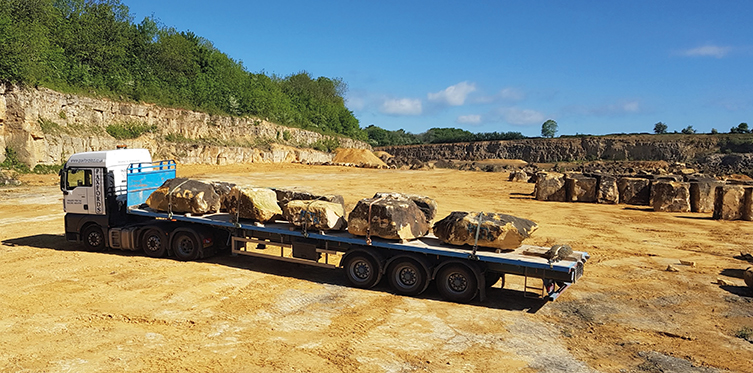Guiting Quarry is back as first blocks of the famous Cotswold limestone leave the site
The first blocks of honey-coloured limestone to leave the famous Guiting Quarry in the Cotswolds for a decade have gone under the saws of Johnston Quarry Group – and “it rings like a bell”, says Director of Operations Paul Keyte.
Nicholas Johnston, who owns the quarry group as well as the Bath Stone Group, announced at the Natural Stone Show at the beginning of May that he had obtained permission to re-open the quarry with the help of former Aggregates Industry Chairman Bill Bolsover.
Guiting Quarry was last successfully operated by Hanson but was effectively sterilised by a dispute between the quarry company and Stanway Estate, where Hanson controlled the access and the Estate the extensive reserve.
Nicholas said: “It took Bill’s knowledge and experience to bring these two parties together and through that process Bill has joined Johnston Quarry Group as a shareholder and non-executive director. We will be spending the next two or three months re-equipping the quarry and bringing Guiting back into full production, offering a full range of block, building and walling stone, high quality single size aggregates and agricultural lime.
“We want to work with stone processors, masons and end users to make a full range of stone available to the market. I’m thrilled that this truly important and historic, quality building stone will now be coming back on stream.
“I’m equally thrilled to be working with Bill Bolsover within the Group. His knowledge and experience will be invaluable as we plan for the inevitable increase in construction activity utilising natural stone after the current political uncertainty has passed.”
Operations ceased with block still on the ground and it is that block that Johnston Quarry Group is now taking out from the 80-acre quarry site.
“There’s enough block on the ground to keep us going for months!” says Paul Keyte. It will mean the quarry can go into production while a ROMP (Review of Old Mineral Permissions) assessment is carried out.
A new weighbridge and wheel wash has already gone into the quarry and while the stone can be easily lifted from the face, a Fantini saw is going to be used to square the blocks before they are moved so that waste is not transported unnecessarily.
While Guiting Quarry has been closed, Johnston Quarry Group has helped satisfy demand for the warm, golden-coloured Cotswold stone from Oathill Quarry, which is close to Guiting. But there are limits to how much stone can be supplied from Oathill, whereas Guiting can supply as much as anyone will realistically want.
Paul Keyte has been keeping local residents on side by talking to them and inviting them to visit the quarry to see the work going on there. He has also been working closely with Gloucestershire County Council. “I live there. I want to be sensitive to the area. I believe that with constructive dialogue and quarry visits people living in the area will get an understanding of what is taking place at the quarry,” he told NSS.
Guiting stone has a long tradition of use in the Cotswolds and was used in the construction of Gloucester Cathedral after the Norman invasion in 1066 as well as in its renovation by George Gilbert Scott towards the end of the 19th century. Many of the Cotswold mansions have also been constructed from the historic stone.
This is Johnston Quarry Group’s seventh quarry and Nicholas Johnston says the Group is also close to re-opening Ropsley Quarry in Lincolnshire and Rollright Quarry just outside Chipping Norton, as well as sinking a new shaft into the mine at Hartham Park to access the Bath Stone, including the premium quality Box Ground there.
Below. The first blocks to leave Guiting Quarry in the Cotswolds for a decade.


